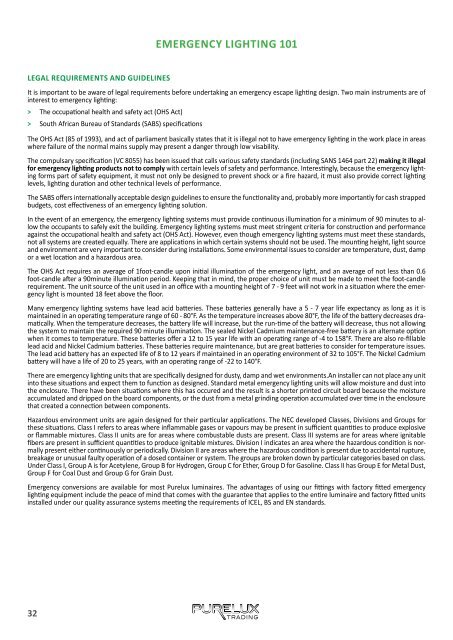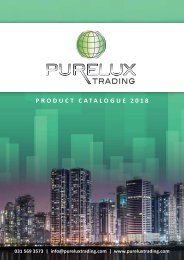Purelux Catalog 2018
Purelux Product Catalog.
Purelux Product Catalog.
Create successful ePaper yourself
Turn your PDF publications into a flip-book with our unique Google optimized e-Paper software.
emergency lighting 101<br />
Legal requirements and guidelines<br />
It is important to be aware of legal requirements before undertaking an emergency escape lighting design. Two main instruments are of<br />
interest to emergency lighting:<br />
> The occupational health and safety act (OHS Act)<br />
> South African Bureau of Standards (SABS) specifications<br />
The OHS Act (85 of 1993), and act of parliament basically states that it is illegal not to have emergency lighting in the work place in areas<br />
where failure of the normal mains supply may present a danger through low visability.<br />
The compulsary specification (VC 8055) has been issued that calls various safety standards (including SANS 1464 part 22) making it illegal<br />
for emergency lighting products not to comply with certain levels of safety and performance. Interestingly, because the emergency lighting<br />
forms part of safety equipment, it must not only be designed to prevent shock or a fire hazard, it must also provide correct lighting<br />
levels, lighting duration and other technical levels of performance.<br />
The SABS offers internationally acceptable design guidelines to ensure the functionality and, probably more importantly for cash strapped<br />
budgets, cost effectiveness of an emergency lighting solution.<br />
In the event of an emergency, the emergency lighting systems must provide continuous illumination for a minimum of 90 minutes to allow<br />
the occupants to safely exit the building. Emergency lighting systems must meet stringent criteria for construction and performance<br />
against the occupational health and safety act (OHS Act). However, even though emergency lighting systems must meet these standards,<br />
not all systems are created equally. There are applications in which certain systems should not be used. The mounting height, light source<br />
and environment are very important to consider during installations. Some environmental issues to consider are temperature, dust, damp<br />
or a wet location and a hazardous area.<br />
The OHS Act requires an average of 1foot-candle upon initial illumination of the emergency light, and an average of not less than 0.6<br />
foot-candle after a 90minute illumination period. Keeping that in mind, the proper choice of unit must be made to meet the foot-candle<br />
requirement. The unit source of the unit used in an office with a mounting height of 7 - 9 feet will not work in a situation where the emergency<br />
light is mounted 18 feet above the floor.<br />
Many emergency lighting systems have lead acid batteries. These batteries generally have a 5 - 7 year life expectancy as long as it is<br />
maintained in an operating temperature range of 60 - 80°F. As the temperature increases above 80°F, the life of the battery decreases dramatically.<br />
When the temperature decreases, the battery life will increase, but the run-time of the battery will decrease, thus not allowing<br />
the system to maintain the required 90 minute illumination. The sealed Nickel Cadmium maintenance-free battery is an alternate option<br />
when it comes to temperature. These batteries offer a 12 to 15 year life with an operating range of -4 to 158°F. There are also re-fillable<br />
lead acid and Nickel Cadmium batteries. These batteries require maintenance, but are great batteries to consider for temperature issues.<br />
The lead acid battery has an expected life of 8 to 12 years if maintained in an operating environment of 32 to 105°F. The Nickel Cadmium<br />
battery will have a life of 20 to 25 years, with an operating range of -22 to 140°F.<br />
There are emergency lighting units that are specifically designed for dusty, damp and wet environments.An installer can not place any unit<br />
into these situations and expect them to function as designed. Standard metal emergency lighting units will allow moisture and dust into<br />
the enclosure. There have been situations where this has occured and the result is a shorter printed circuit board because the moisture<br />
accumulated and dripped on the board components, or the dust from a metal grinding operation accumulated over time in the enclosure<br />
that created a connection between components.<br />
Hazardous environment units are again designed for their particular applications. The NEC developed Classes, Divisions and Groups for<br />
these situations. Class I refers to areas where inflammable gases or vapours may be present in sufficient quantities to produce explosive<br />
or flammable mixtures. Class II units are for areas where combustable dusts are present. Class III systems are for areas where ignitable<br />
fibers are present in sufficient quantities to produce ignitable mixtures. Division I indicates an area where the hazardous condition is normally<br />
present either continuously or periodically. Division II are areas where the hazardous condition is present due to accidental rupture,<br />
breakage or unusual faulty operation of a dosed container or system. The groups are broken down by particular categories based on class.<br />
Under Class I, Group A is for Acetylene, Group B for Hydrogen, Group C for Ether, Group D for Gasoline. Class II has Group E for Metal Dust,<br />
Group F for Coal Dust and Group G for Grain Dust.<br />
Emergency conversions are available for most <strong>Purelux</strong> luminaires. The advantages of using our fittings with factory fitted emergency<br />
lighting equipment include the peace of mind that comes with the guarantee that applies to the entire luminaire and factory fitted units<br />
installed under our quality assurance systems meeting the requirements of ICEL, BS and EN standards.<br />
32<br />
trading




